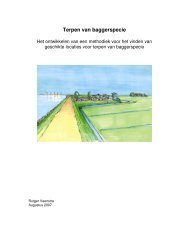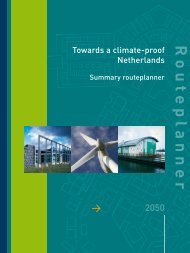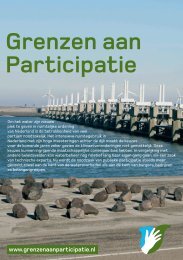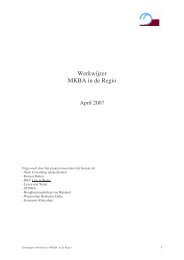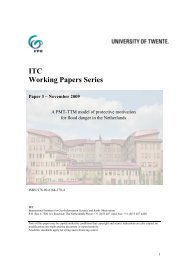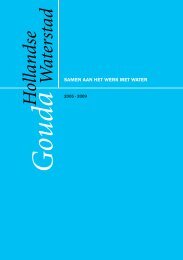Deltas on the move; Making deltas cope with the effects of climate c
Deltas on the move; Making deltas cope with the effects of climate c
Deltas on the move; Making deltas cope with the effects of climate c
- No tags were found...
You also want an ePaper? Increase the reach of your titles
YUMPU automatically turns print PDFs into web optimized ePapers that Google loves.
KvR report 001/2006For <strong>the</strong> river we explored <strong>the</strong> discharge <strong>of</strong> water versus <strong>the</strong> transport <strong>of</strong> sediment. Indeltaic envir<strong>on</strong>ments, <strong>the</strong> discharge <strong>of</strong> river water can also be important as a variablepotentially related to flooding. The seawater related variables in WDD (spring tideand wave power and height, that were elaborated before) could be combined <strong>with</strong>,e.g., height <strong>of</strong> <strong>the</strong> dikes from Diva (secti<strong>on</strong>s 2 and 3 in this Annex) for fur<strong>the</strong>r analysis<strong>of</strong> probability <strong>of</strong> flooding by <strong>the</strong> sea. The outlier resp<strong>on</strong>sible for decreasing <strong>the</strong>correlati<strong>on</strong> coefficients is Huang He (Yellow River), which seems to have anextremely high sediment discharge (980 x 109 kg/yr) for its water discharge.Figure 4:Correlati<strong>on</strong>s <strong>of</strong> river water discharge and sediment discharge.<str<strong>on</strong>g>Deltas</str<strong>on</strong>g> <strong>on</strong> <strong>the</strong> <strong>move</strong>This analysis was performed <strong>on</strong> a selecti<strong>on</strong> <strong>of</strong> <strong>the</strong> WDD dataset as described inTable 5.3 <strong>with</strong>out sediment discharge and wave power, because <strong>of</strong> a relatively lownumber <strong>of</strong> available observati<strong>on</strong>s for <strong>the</strong>se variables. For <strong>the</strong> WDD dataset:- The first axis comprises annual average discharge, maximum discharge,minimum discharge and delta area and shoreline. It explains 37 % <strong>of</strong> <strong>the</strong> totalvariati<strong>on</strong>. This comp<strong>on</strong>ent describes river-form relati<strong>on</strong>ships.- The sec<strong>on</strong>d comp<strong>on</strong>ent comprised subaerial/subaqueous and <strong>of</strong>fshore slope, andexplains 18.5 % <strong>of</strong> <strong>the</strong> variati<strong>on</strong>. These describe sediment availability and form.- The third comp<strong>on</strong>ent comprises spring tide, rms wave height and number <strong>of</strong> rivermouths, and explains 14.5 % <strong>of</strong> <strong>the</strong> variati<strong>on</strong>. It seems to describe marine forcesversus a form relati<strong>on</strong>ship number <strong>of</strong> river mouths (Number <strong>of</strong> river mouths ishigher <strong>on</strong> a gently sloping delta).sed discharge (10 9 kg/yr)sed discharge (10 9 kg/yr)1000.00y = 0.444x 0.63800.00R 2 = 0.45600.00400.00200.000.000 10000 20000 30000annual ave discharge (m 3 /s)1000.00y = 46.88e 0.0002x800.00R 2 = 0.25600.00400.00200.000.000 3000 6000 9000 12000min discharge (m 3 /s)sed discharge (10 9 kg/yr)annual ave discharge (m 3 /s)1000.00800.00600.00400.00200.00y = 0.923x 0.508R 2 = 0.270.000 20000 40000 60000 80000 1000003000020000100000max discharge (m 3 /s)y = 0.37x + 878.88R 2 = 0.830 20000 40000 60000 80000 100000max discharge (m 3 /s)In total 70% <strong>of</strong> <strong>the</strong> variati<strong>on</strong> in <strong>the</strong> (tested part <strong>of</strong> <strong>the</strong>) WDD dataset was described<strong>with</strong> <strong>the</strong>se 3 axes. Using <strong>on</strong>ly <strong>on</strong>e separate variable from each axis would alreadyallow characterizing <strong>the</strong> form <strong>of</strong> <strong>the</strong> <strong>deltas</strong> from causes related to river, sedimentavailability, and marine forces.2 DIVA indicator testingCombining <strong>of</strong> <strong>the</strong> 43 WDD <strong>deltas</strong> <strong>with</strong> <strong>the</strong> 115 rivers available in DIVA did not resultin a complete match. Several rivers end up in lakes (e.g. Amu Darya in <strong>the</strong> Aral Seaand <strong>the</strong> Salenga in Lake Baikal), some <strong>deltas</strong> are not covered in <strong>the</strong> DIVA river set(e.g. Baram, Colville, Grijalva, Klang, Ord). Many DIVA rivers obviously have noclear delta. This led to a coupled set <strong>of</strong> 34 rivers.Physical vulnerabilityTwo major compound indicators available in DIVA are <strong>the</strong> segment vulnerabilityscore (CSVS) and accommodati<strong>on</strong> space (ASPACE). The <strong>deltas</strong> studied hereappear to vary <strong>on</strong>ly slightly in CSVS. This scaled, categorical indicator variesbetween 2.5 and 3.5 <strong>on</strong>ly (Figure 5). In c<strong>on</strong>trast, accommodati<strong>on</strong> space shows awider span. It must be noted that a high score in DIVA indicates high vulnerability,thus a high value for ASPACE suggests that <strong>the</strong>re is little room for accommodati<strong>on</strong> in<strong>the</strong> adjacent hinterland. Apparently, <strong>the</strong> bulk (28 <strong>of</strong> 34) <strong>of</strong> <strong>the</strong> <strong>deltas</strong> is estimated tohave substantial accommodati<strong>on</strong> space for inland migrati<strong>on</strong> <strong>of</strong> <strong>the</strong> present coastline.Finally, a principal comp<strong>on</strong>ent analysis was performed. Principal comp<strong>on</strong>entsanalysis (PCA) is a statistical technique that can be used to simplify a dataset (cfJ<strong>on</strong>gman et al., 1987). It is a linear transformati<strong>on</strong> that chooses a new coordinatesystem for <strong>the</strong> data set such that <strong>the</strong> greatest variance by any projecti<strong>on</strong> <strong>of</strong> <strong>the</strong> dataset comes to lie <strong>on</strong> <strong>the</strong> first axis (also called <strong>the</strong> first principal comp<strong>on</strong>ent), <strong>the</strong>sec<strong>on</strong>d greatest variance <strong>on</strong> <strong>the</strong> sec<strong>on</strong>d axis, and so <strong>on</strong>. PCA can be used forreducing dimensi<strong>on</strong>ality in a dataset while retaining those characteristics <strong>of</strong> <strong>the</strong>dataset that c<strong>on</strong>tribute most to its variance, by keeping lower-order principalcomp<strong>on</strong>ents and ignoring higher-order <strong>on</strong>es. The idea is that such low-ordercomp<strong>on</strong>ents <strong>of</strong>ten c<strong>on</strong>tain <strong>the</strong> most important aspects <strong>of</strong> <strong>the</strong> data. However, this isnot necessarily <strong>the</strong> case, depending <strong>on</strong> <strong>the</strong> applicati<strong>on</strong>.The two outliers are <strong>the</strong> Niger in Nigeria and <strong>the</strong> Mangoky in Madagascar. One <strong>of</strong> <strong>the</strong>c<strong>on</strong>stituent variables <strong>of</strong> <strong>the</strong> CSVS is sediment supply (SEDSUP). This again is acategorical indicator <strong>with</strong> 5 classes and class 1 indicating high sediment supply thuslow vulnerability, whereas 5 indicates high vulnerability. All 34 <strong>deltas</strong> and 115 DIVArivers, however, have been classified as bel<strong>on</strong>ging to category 3 (moderate) or 4(high to moderate vulnerability), limiting <strong>the</strong> usefulness <strong>of</strong> this indicator. Wave<strong>climate</strong>, maximum surge height, tidal range and coastal slope all span a substantialrange: clearly hydrodynamic c<strong>on</strong>diti<strong>on</strong>s in adjacent coastal waters differ am<strong>on</strong>g<strong>deltas</strong>.8889



